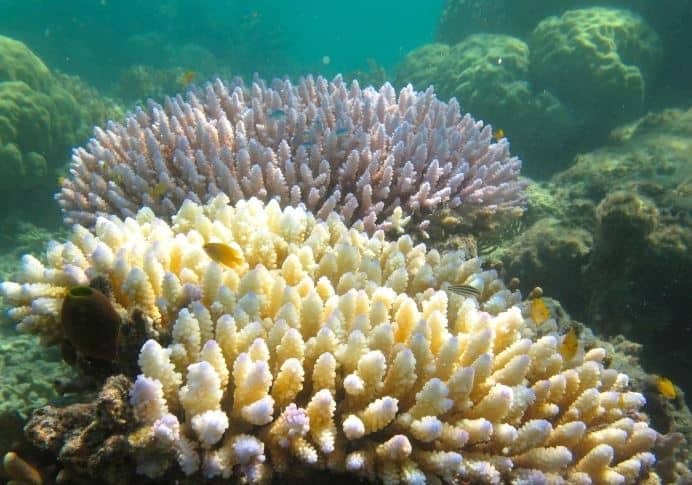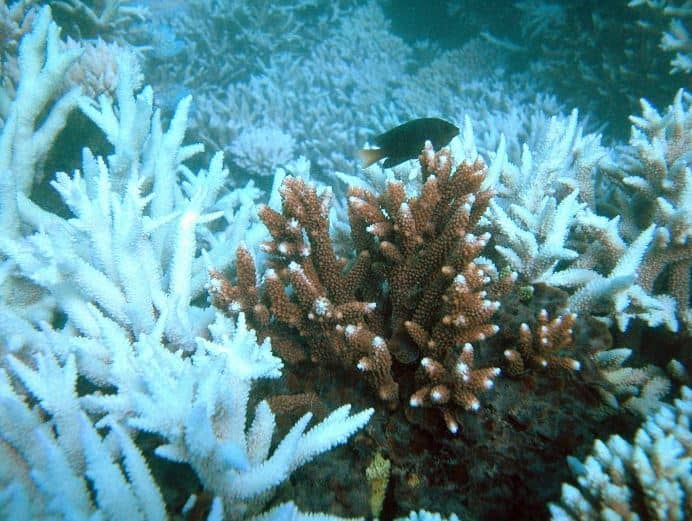After carrying out several aerial surveys of over 500 coral reefs from Papua New Guinea to Cairns in Australia, most of them have been ranked in the most severe bleaching category, says the ARC (Australian Research Council) Centre of Excellence for Coral Reef Studies. If we don’t take urgent action now, the Great Barrier Reef could eventually face total extinction, scientists warn.
The most virgin section of the Great Barrier Reef is today experiencing the worst mass bleaching event in all its history, scientists reported.
The world’s largest living structure
The Great Barrier Reef, found in the Coral Sea off the coast of Queensland Australia, is the largest coral reef system in the world. Consisting of 2,900 individual reefs and 900 islands, it is the largest living structure on Earth – visible with the naked eye from space.
 The Great Barrier Reef stretches over 2,300 km. It is a unique natural treasure and one of the most biologically diverse areas in the world. It is under pressure: coastal development, climate change, catchment run-off and outbreaks of crown-of-thorns starfish are some of the most serious threats facing the Reef today. (Image: coralcoe.org.au)
The Great Barrier Reef stretches over 2,300 km. It is a unique natural treasure and one of the most biologically diverse areas in the world. It is under pressure: coastal development, climate change, catchment run-off and outbreaks of crown-of-thorns starfish are some of the most serious threats facing the Reef today. (Image: coralcoe.org.au)
Marine animals called coral play a major role in the formation of the Great Barrier Reef. It is home to a vast rage of fauna and flora, including sea snakes, sharks, stingray, sea turtles, nudibranch, seahorses, giant clams, whales, dolphins and other marine creatures.
Regarding the latest study on the health of the Great Barrier Reef, Professor Ted Hughes, convenor of the National Coral Bleaching Taskforce, said:
“This has been the saddest research trip of my life. Almost without exception, every reef we flew across showed consistently high levels of bleaching, from the reef slope right up onto the top of the reef. We flew for 4000km in the most pristine parts of the Great Barrier Reef and saw only four reefs that had no bleaching. The severity is much greater than in earlier bleaching events in 2002 or 1998.”
“Even more concerning, we haven’t yet found the southern limit of the bleaching,. We’ll be conducting further aerial surveys this week in the central Great Barrier Reef to identify where it stops. Thankfully, the southern Reef has dodged a bullet due to cloudy weather that cooled the water temperatures down.”
Virtually all coral species affected
Widespread and severe coral bleaching is also being documented by several island research stations and research vessels, confirming what is clearly evident from the air. Tragically, the vast majority of reefs north of Cairns, considered Australia’s gateway to the Great Barrier Reef, are undergoing bleaching – virtually every species of coral is affected.
 According to the National Oceanic and Atmospheric Administration, part of the US Department of Commerce: “When corals are stressed by changes in conditions such as temperature, light, or nutrients, they expel the symbiotic algae living in their tissues, causing them to turn completely white.”
According to the National Oceanic and Atmospheric Administration, part of the US Department of Commerce: “When corals are stressed by changes in conditions such as temperature, light, or nutrients, they expel the symbiotic algae living in their tissues, causing them to turn completely white.”
James Kerry, Project Manager of the National Coral Bleaching Taskforce, who took part in the aerial survey, said:
“We could see extensive bleaching even among the most robust ‘massive’ corals. The fact that these hardy species have also turned white shows just how severe summer conditions have become on the northern GBR (Great Barrier Reef).”
“Residents we spoke to in Cape York were shocked by what they are seeing, telling us that they had never experienced anything like this before.”
Regarding coral mortality, Prof. Hughes said:
“Scientists in the water are already reporting up to 50% mortality of bleached corals. But it’s still too early to tell just what the overall outcome will be. We will continue to conduct underwater surveys along the Great Barrier Reef in the coming months as the full impact of this mass bleaching event unfolds.”
Climate change and coral bleaching
Our planet’s climate is currently undergoing fundamental shifts, both in changing average weather conditions and how often extreme weather events occur.
Evidence is now clear and compelling that Earth’s climate system is warming, and it is extremely probable (95+% probability) that these changes are largely the result of human activities.
Corals inhabiting tropical coral reefs are thermally sensitive; they can only tolerate a narrow range of temperatures. Climate change is pushing sea-surface temperatures to abnormally high levels, which is causing corals to bleach, mainly during the summer months.
 Bleached Acropora plate coral, next to unbleached Montipora coral at Cleveland Bay, located on the north-eastern coast of Queensland. (Image: coralcoe.org.au, Credit: Andrew Baird)
Bleached Acropora plate coral, next to unbleached Montipora coral at Cleveland Bay, located on the north-eastern coast of Queensland. (Image: coralcoe.org.au, Credit: Andrew Baird)
As temperatures continue to climb, so does the intensity of coral bleaching.
In recent decades, there have been two major bleaching events in the Great Barrier reef:
– 1998: 42% of reefs were affected by bleaching.
– 2002: 54% of reefs were affected by bleaching.
How does coral bleaching occur
Zooxanthellae are minuscule, colourful marine algae that live inside corals. They provide corals with much of their colour and, most importantly, their principal supply of energy. The algae cannot survive when the surrounding sea temperature gets too warm – they die.
Coral bleaching occurs when these zooxanthellae die. Without zooxanthellae coral tissue becomes transparent, revealing its white skeleton beneath.
Coral bleaching can lead to the death of corals if unfavourable conditions persist. If sea temperatures return to normal levels, however, zooxanthellae concentrations can recover. Even so, after a bleaching event the stress can result in a decrease in growth and reproduction.
 Bleached Branching Acropora on Lizard Island in Queensland, Australia. (Image: coralcoe.org.au. Credit: Bridie Gibbs)
Bleached Branching Acropora on Lizard Island in Queensland, Australia. (Image: coralcoe.org.au. Credit: Bridie Gibbs)
Coral reef resilience
Future bleaching events are going to happen, regardless of what we try to do. However, there are several steps we can take, locally, regionally and internationally to give the Great Barrier Reef a fighting chance at survival.
Regarding improving the outlook for the Great Barrier Reef, the ARC Centre of Excellence for Coral Reef Studies writes:
“A concerted effort to reduce global carbon emissions will lessen the rise of ocean temperatures and ocean acidification. At the state level, we need to substantially improve the quality of water flowing on to the Reef.”
“Poor water quality is particularly harmful for coral growth, reproduction and the survival of young corals, severely limiting reef recovery potential. Furthermore, research shows that excessive nutrients arriving on the Great Barrier Reef trigger harmful crown-of-thorns outbreaks, which can devastate vast areas of the reef.”
 Fish are still abundant among bleached coral. However, scientists say they are worried about the future. (Image: coralcoe.org.au. Credit: Verena Schoepf)
Fish are still abundant among bleached coral. However, scientists say they are worried about the future. (Image: coralcoe.org.au. Credit: Verena Schoepf)
How effectively we manage coastal development, trawling, shipping, pollution and fishing will play a crucial part in determining the future resilience of the Great Barrier Reef.
Depressing description of widespread damage
Scientists from James Cook University at Cairns, Queensland, Australia, have described scenes of widespread damage as coral bleaching spreads further in the northern Great Barrier Reef.
Dr. Jodie Rummer, a Senior Research Fellow from the ARC Centre of Excellence for Coral Reef Studies, has recently returned from more than a month at Lizard Island Research Station, located in the Northern Great Barrier Reef. She was ‘appalled’ by the extent of the bleaching.
Dr. Rummer said:
“I witnessed a sight underwater that no marine biologist, and no person with a love and appreciation for the natural world for that matter, wants to see.”
Dr. Rummer has been conducting research on the island for the past four years. It is one of the most pristine sites in the entire Great Barrier Reef. Earlier this year, she spend five weeks underwater, studying the effects of extreme heat on the physiology of fishes that live in the waters surrounding the reef.
Regarding the extent of the bleaching, Dr. Rummer said:
“The bleaching now is not just restricted to the hard corals. There’s also extensive bleaching in the soft corals, and it is also affecting anemones and giant clams.”
Dr. Rummer, who described the even as ‘catastrophic’, said fish are still abundant, but the is worried for the future.
Dr. Rummer added:
“We know that many of these tropical populations of reef fishes cannot tolerate dramatic increases in temperatures for extended periods of time. So it may be just a matter of time before the fish start feeling the heat as well. We’re watching them closely.”
“This year, the combination of El Niño, climate change, and an extended period of hot summer days when the tide was exceptionally low has caused many of the corals that survived last year’s cyclone to lose their symbiotic algae and start bleaching.”
Video – Northern Great Barrier Reef coral bleaching
According to ABC’s 7.40 program, a recent extensive study has shown that 95% of the northern Great Barrier Reef is severely bleached – much worse than previously thought.
